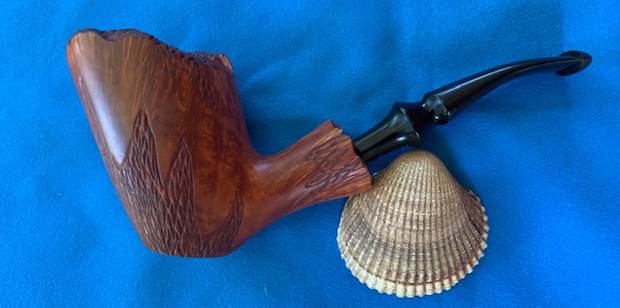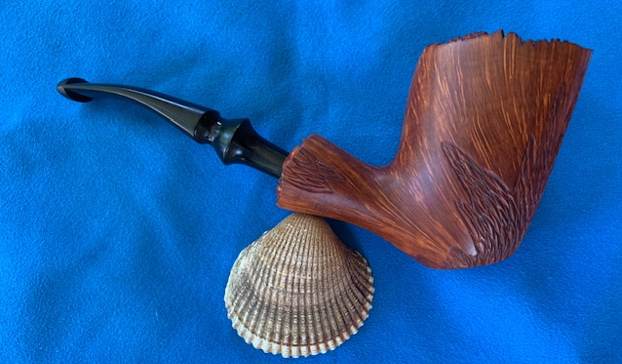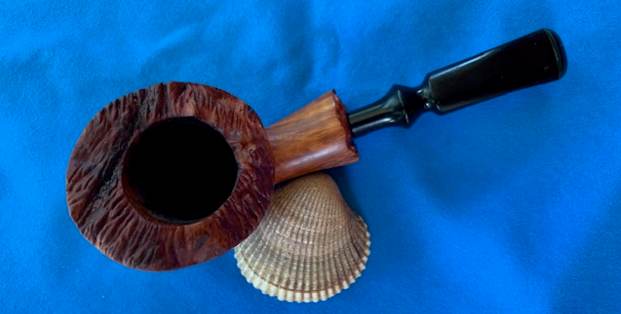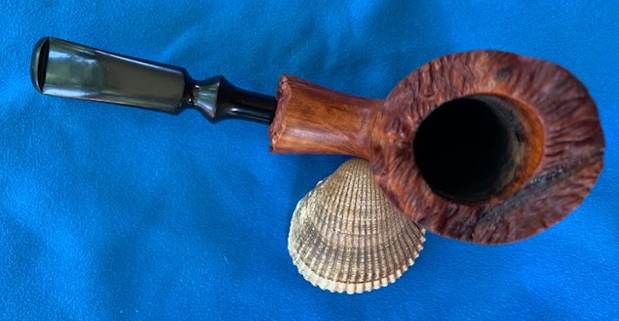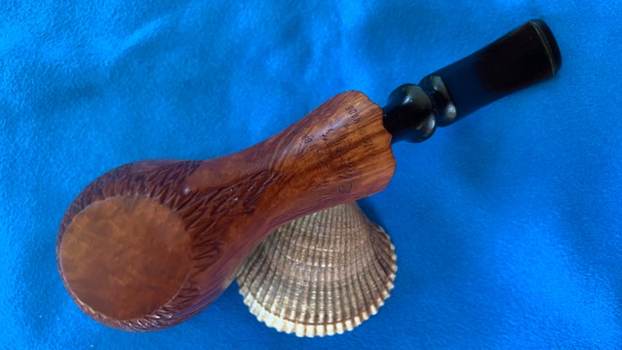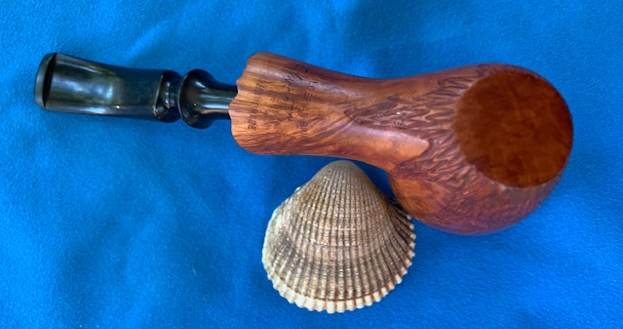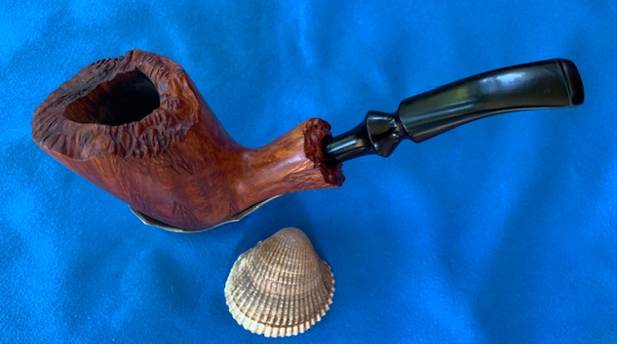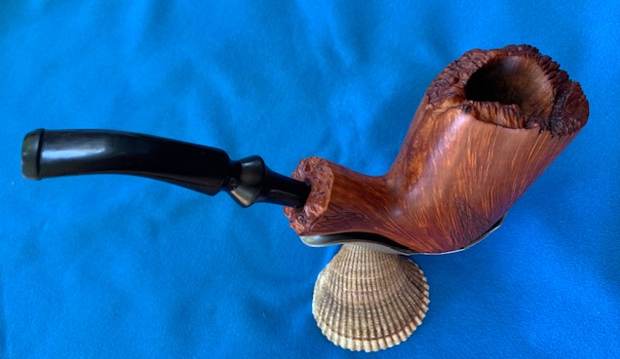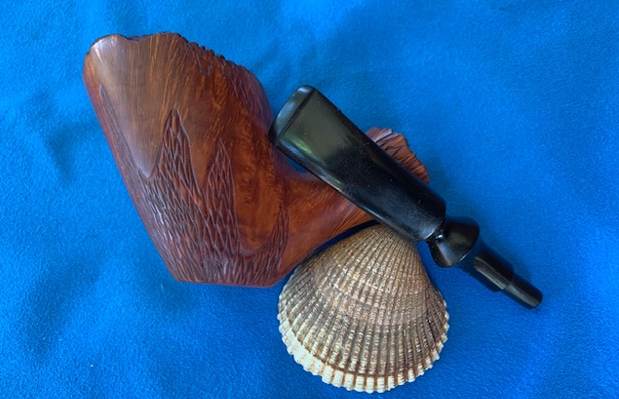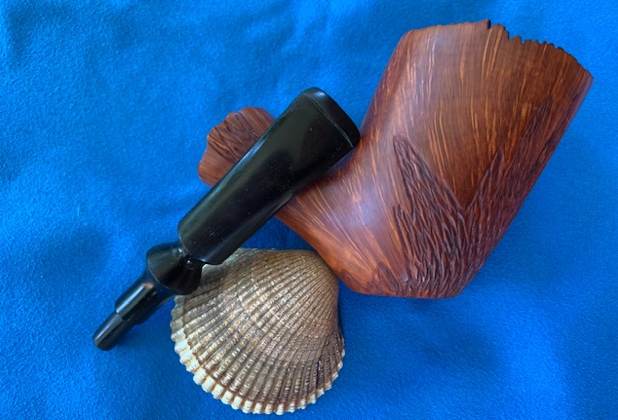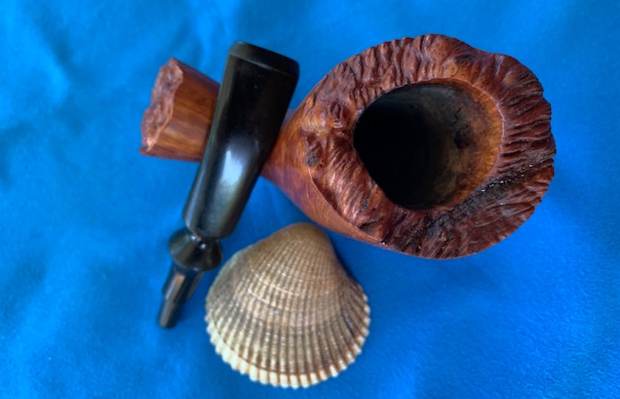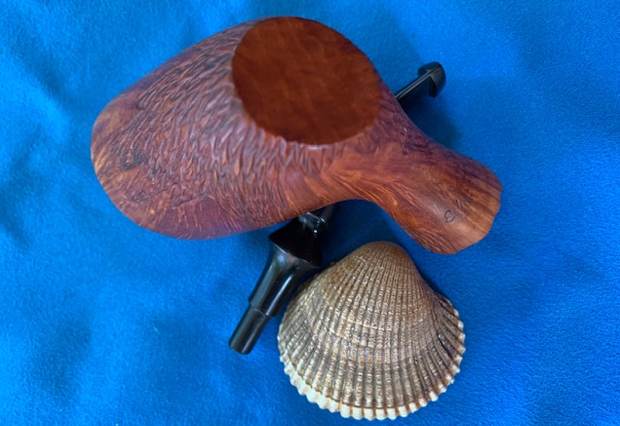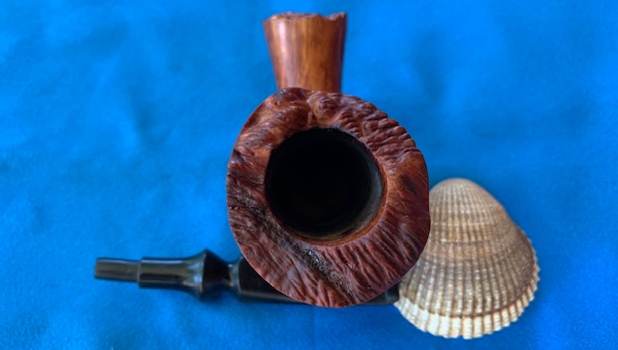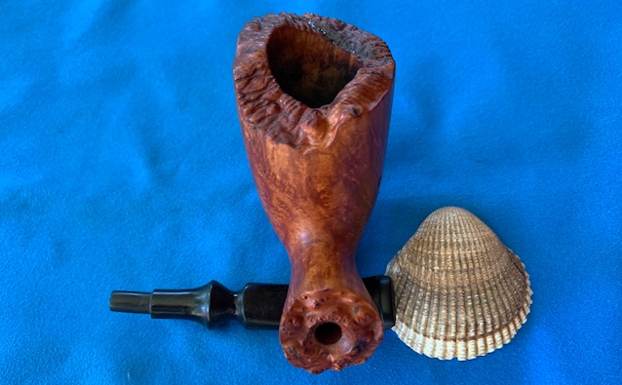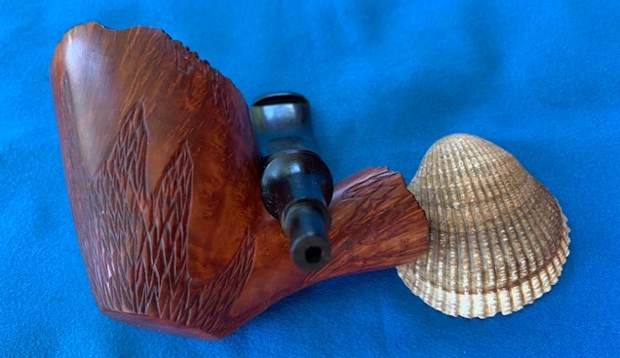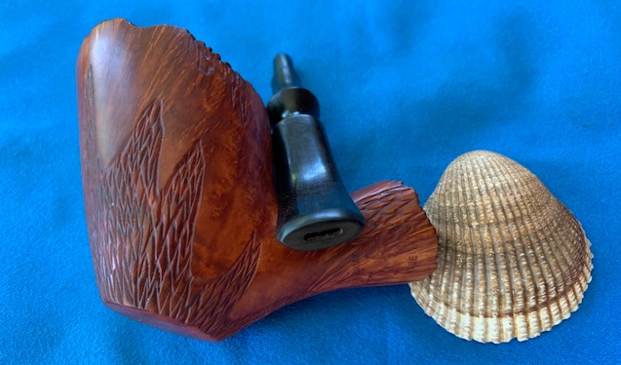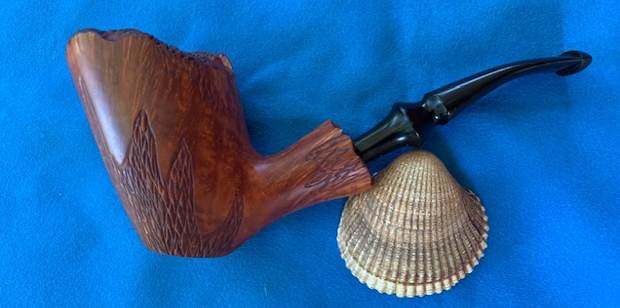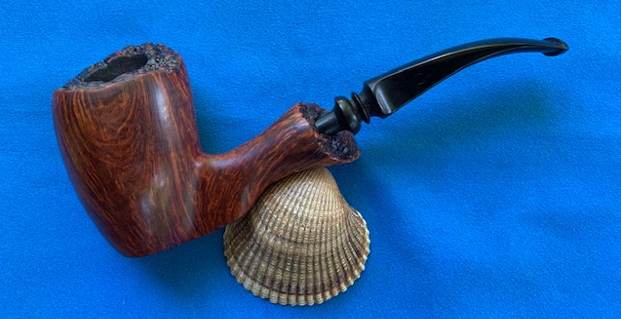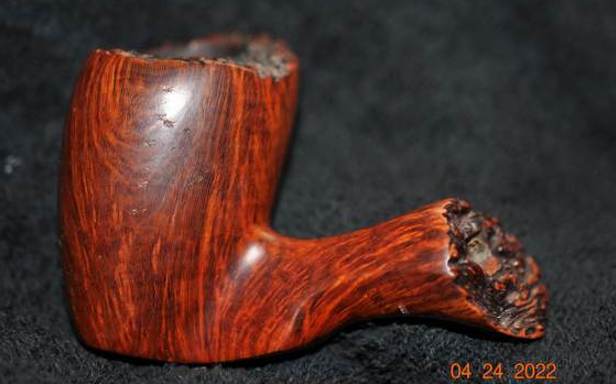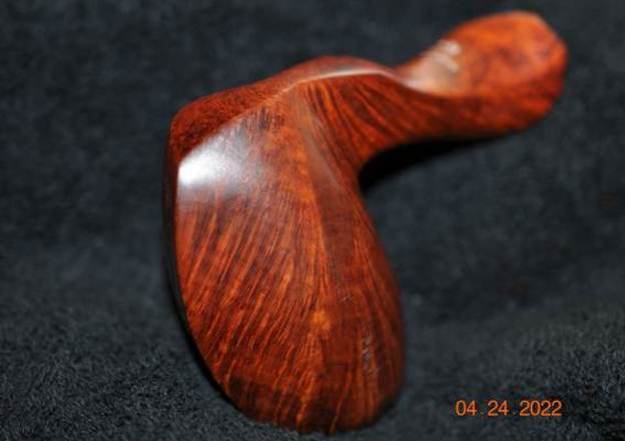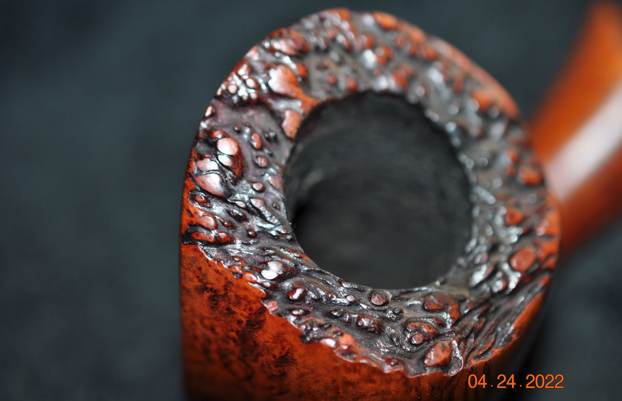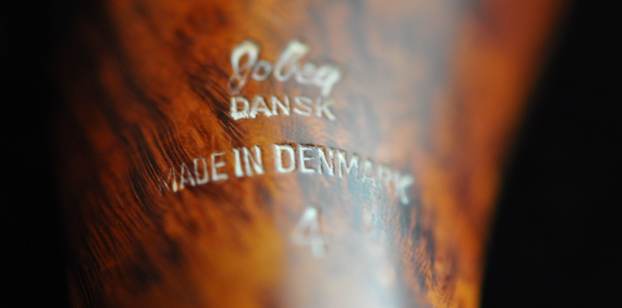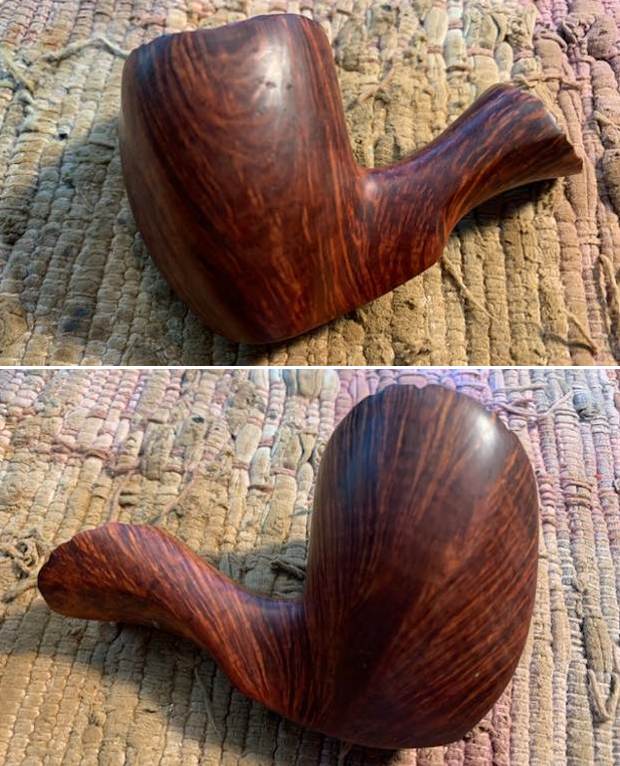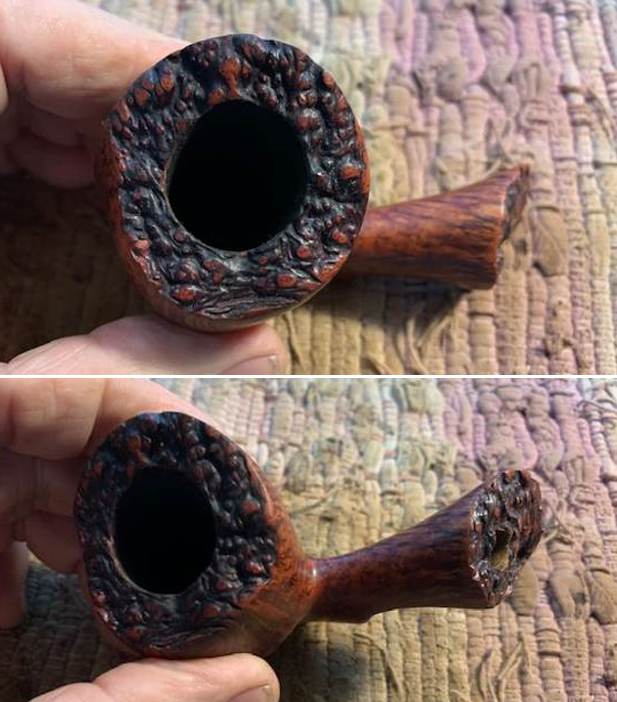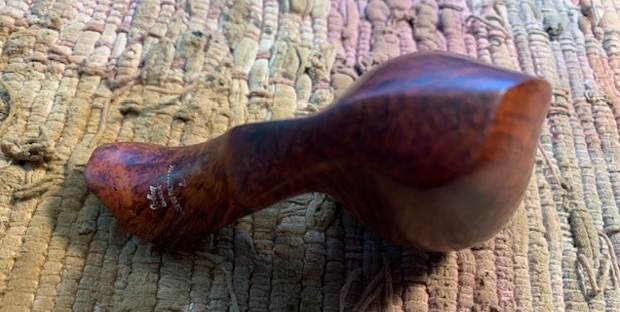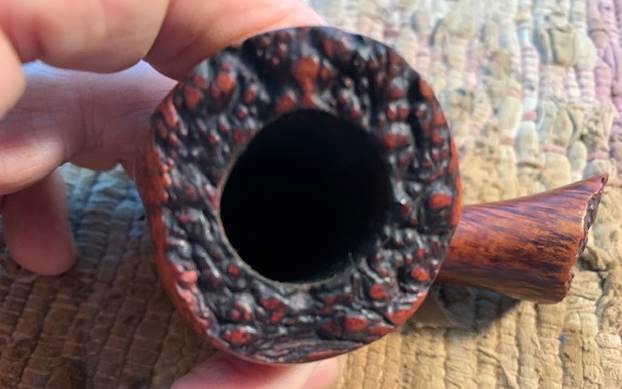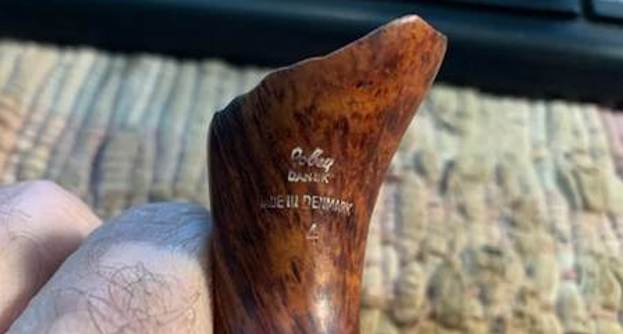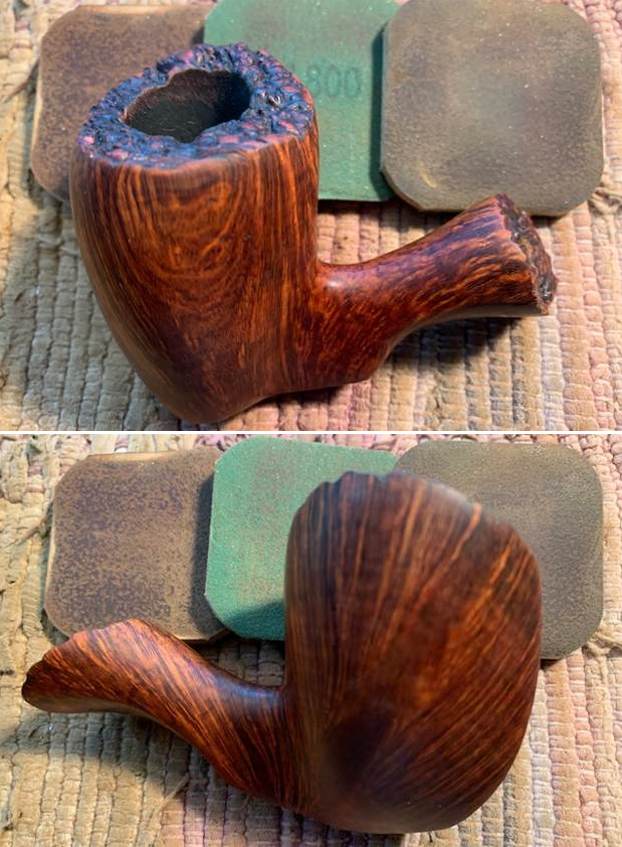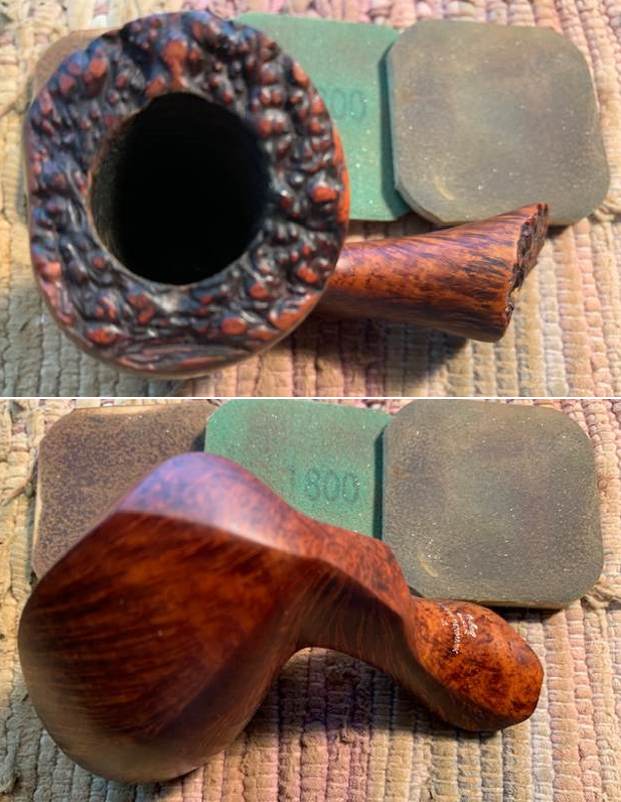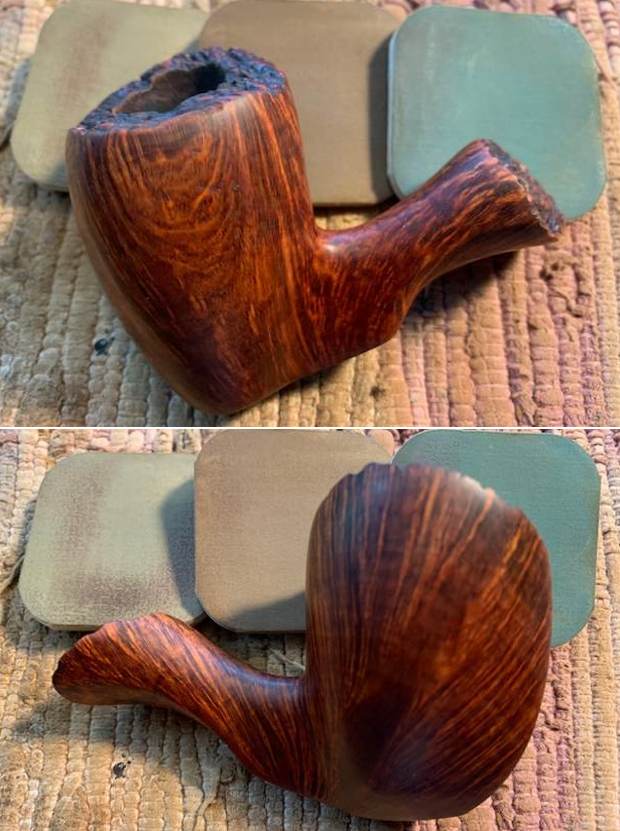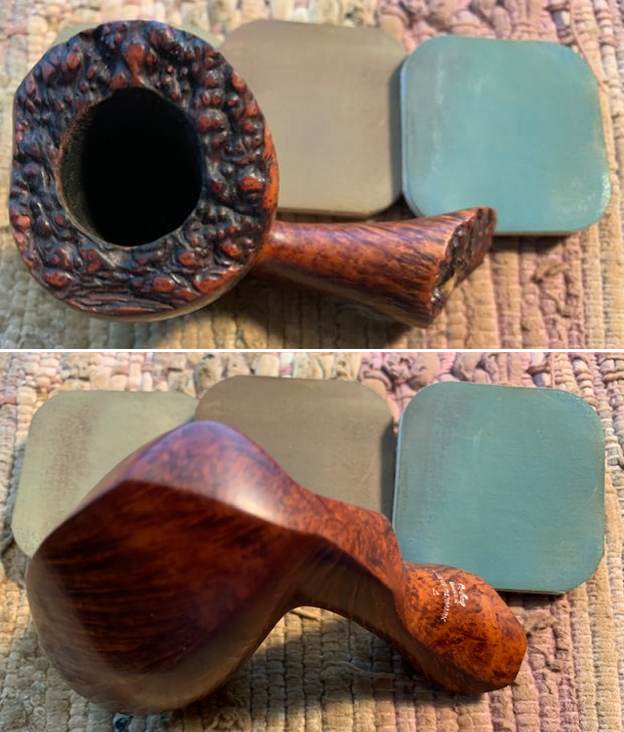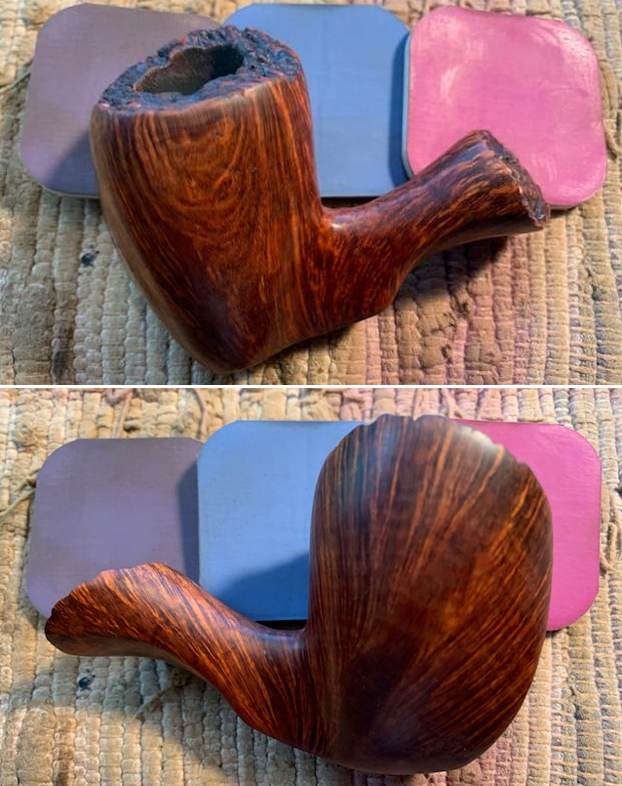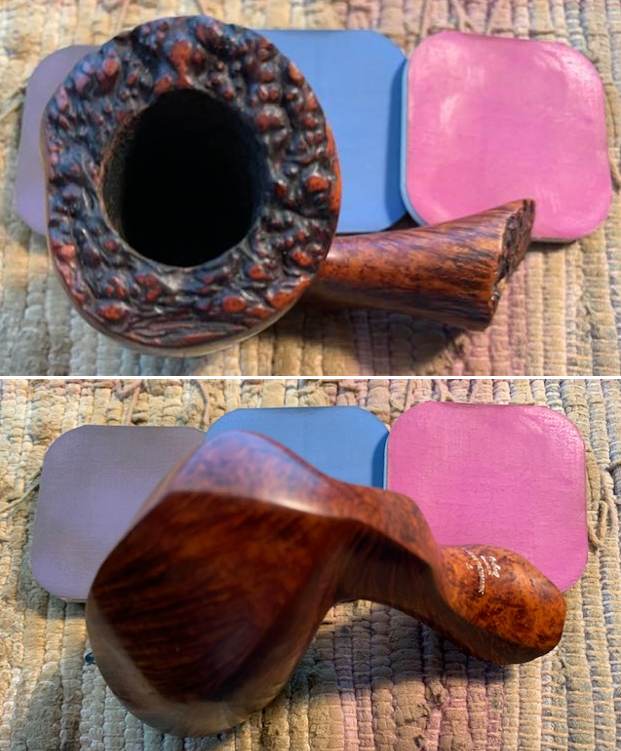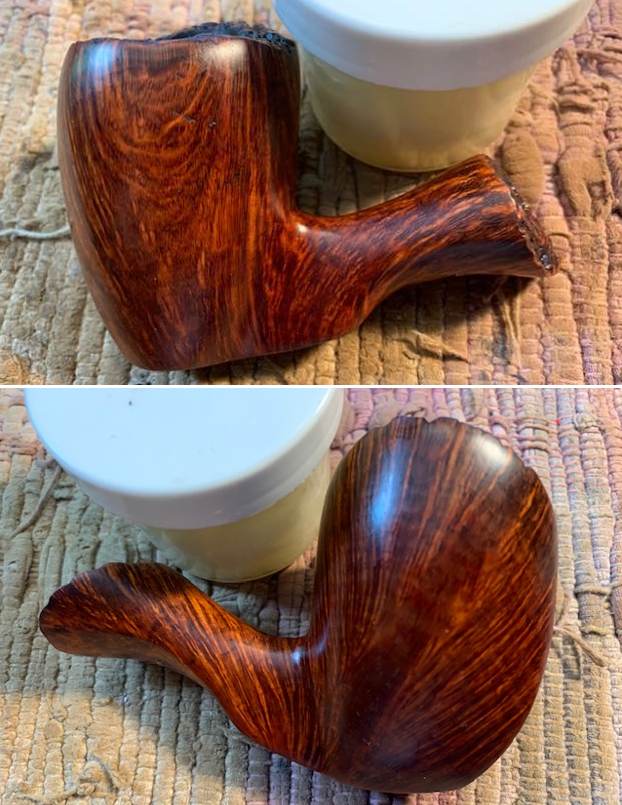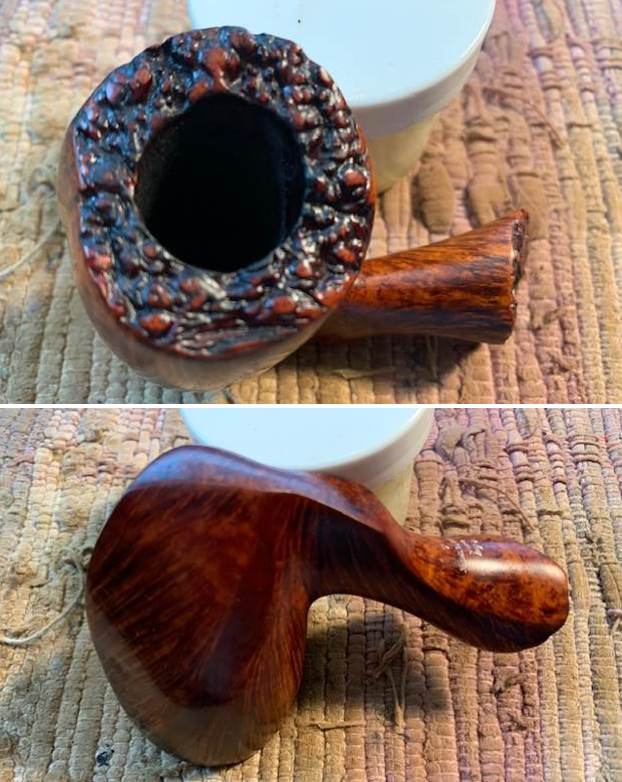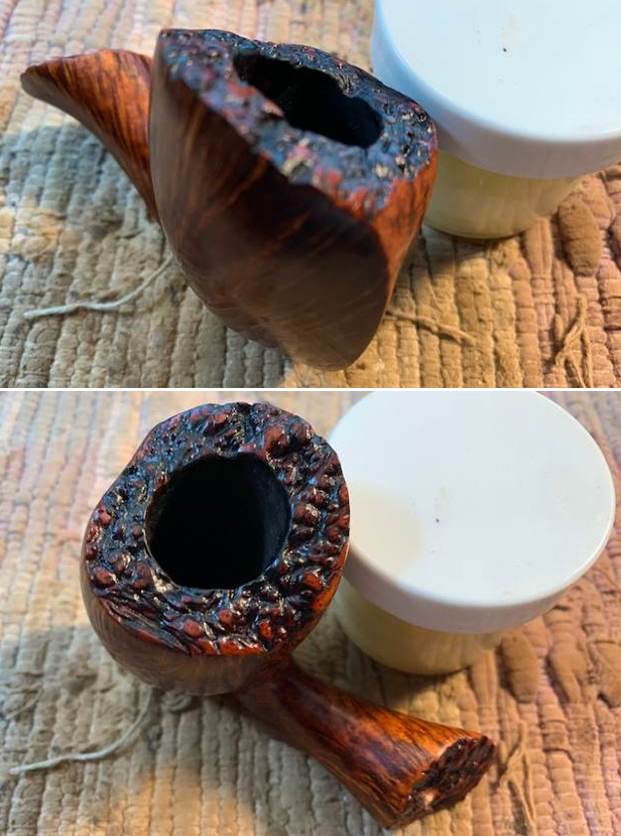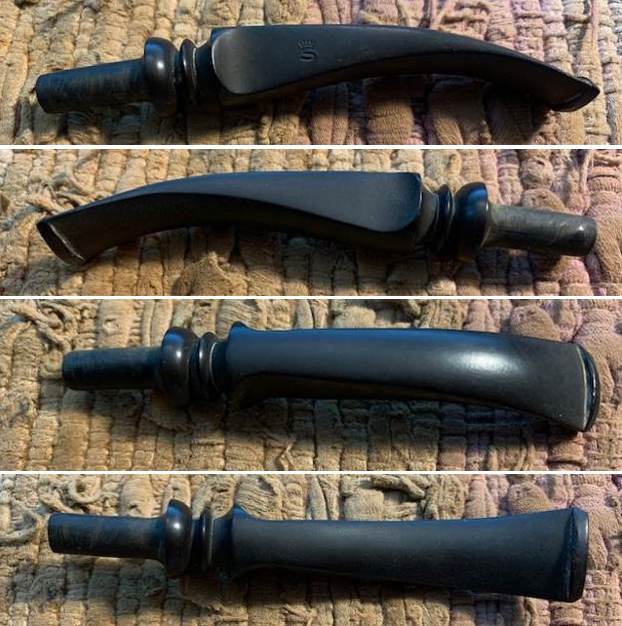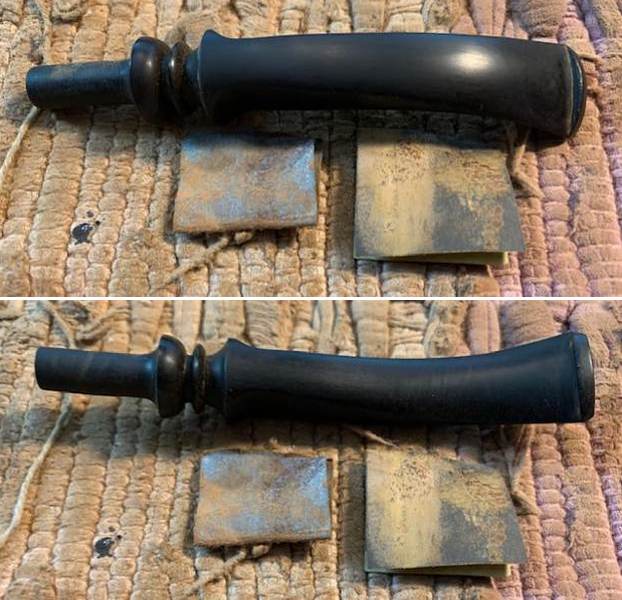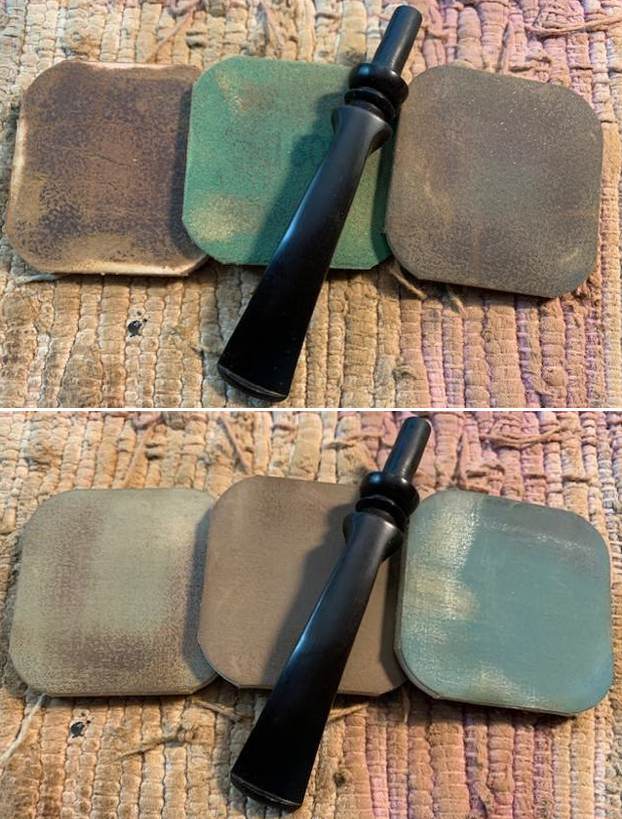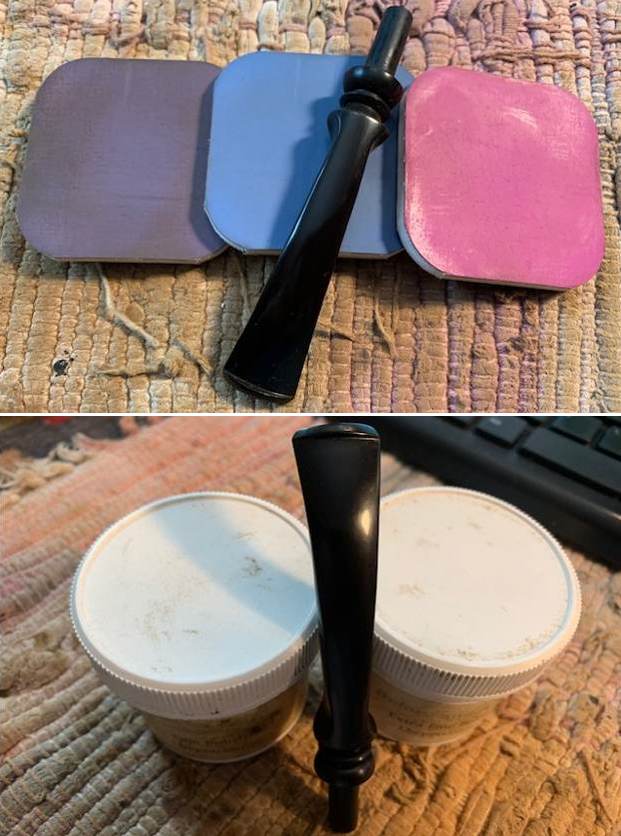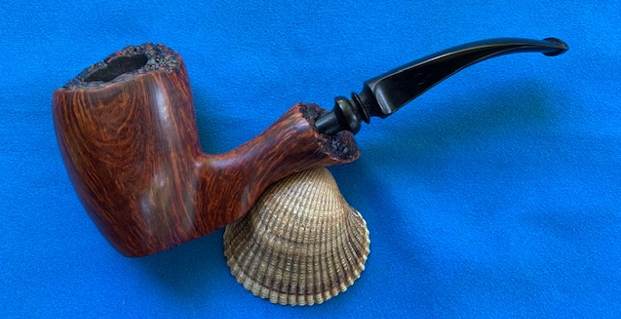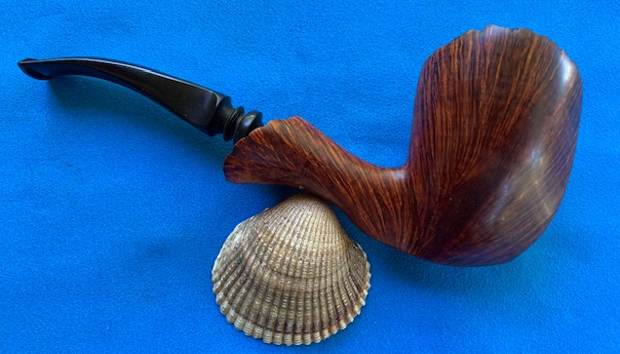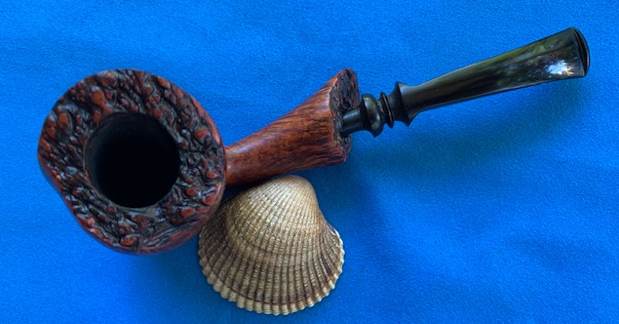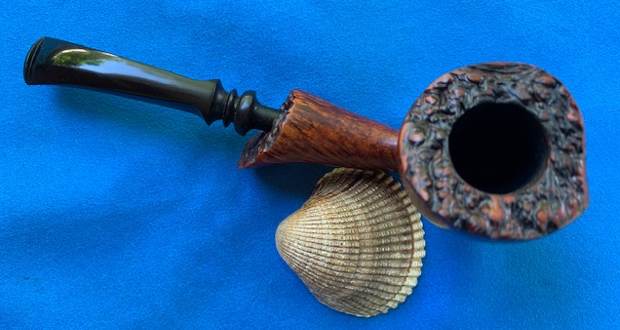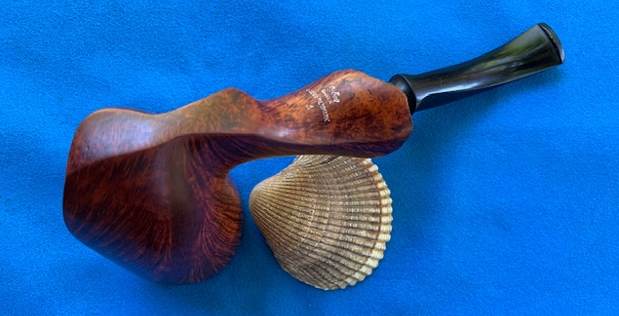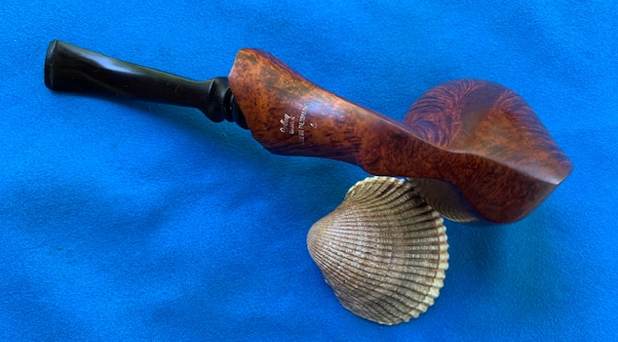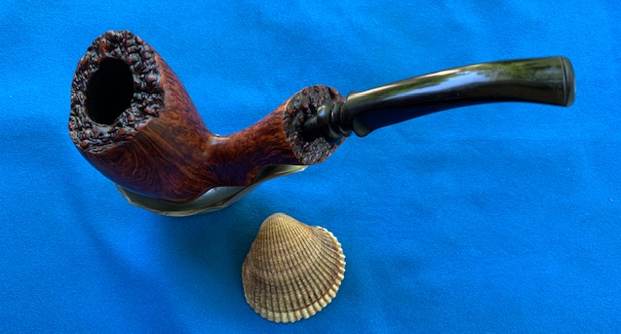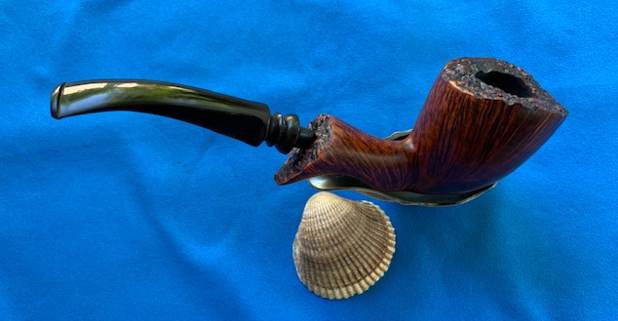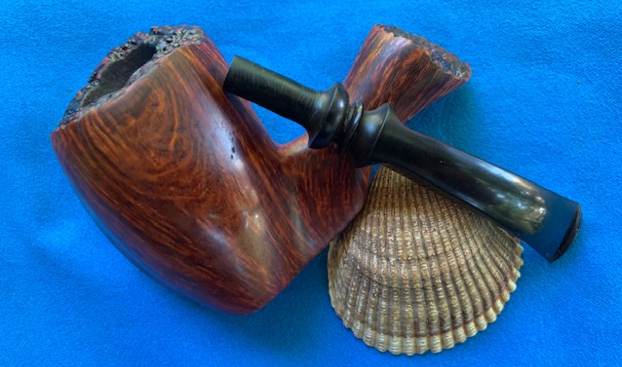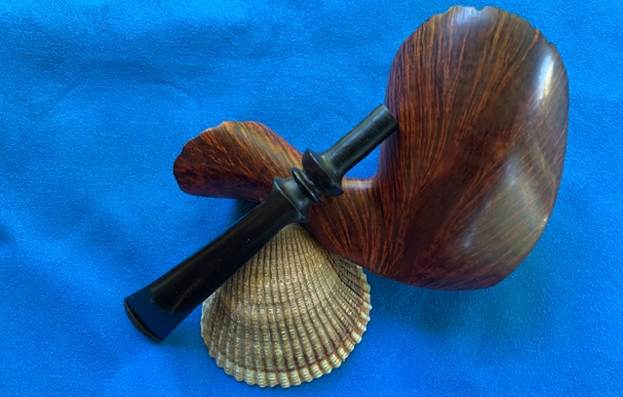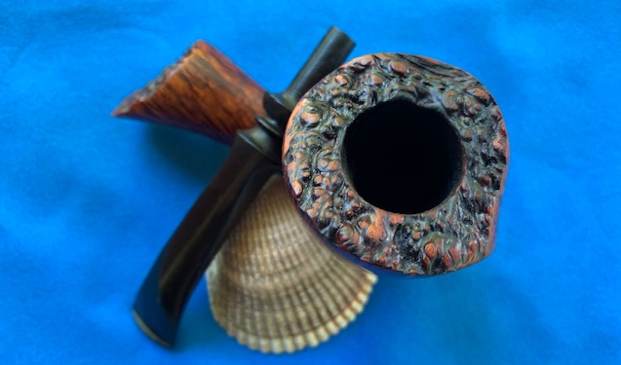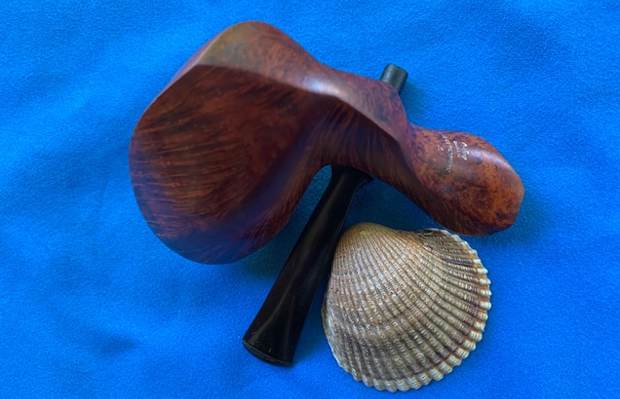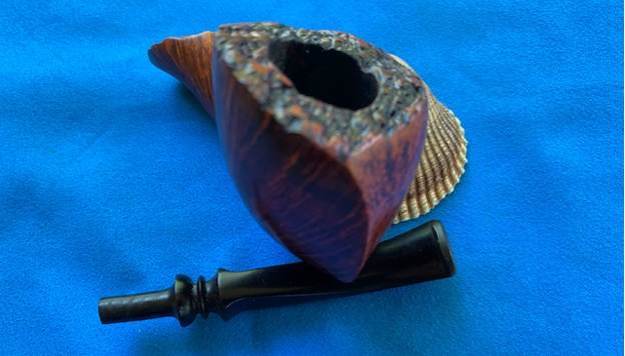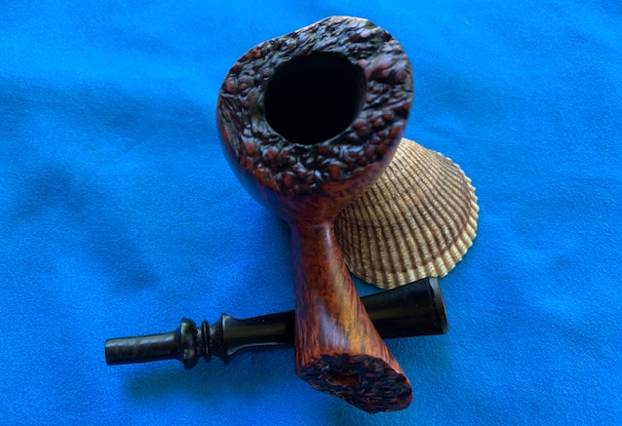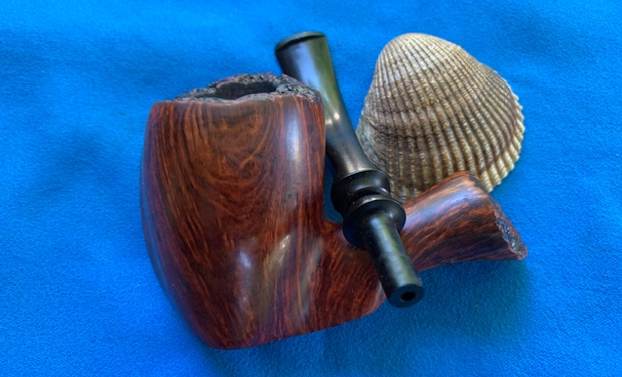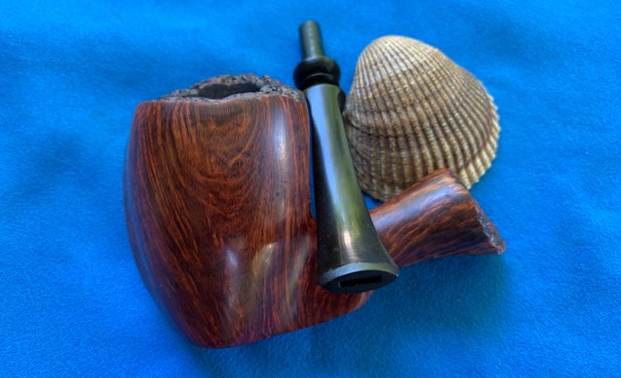Blog by Steve Laug
Jeff and I purchased a group of pipes on 09/04/20 from Gonzales, Louisiana, USA. It included this Edwards Algerian Briar BF 1 Handmade freehand bowl. It had really nice grain and plateau on the top of the rim and on the end of the shank. I had what looked like a leaf on the sides and front of the bowl and underside of the shank. It as also on the sides of the shank.It was stamped on the underside of the shank and read Algerian Briar [over] Edwards [over] 8F [over] 1 [over] Handmade. The carving followed the flow of the grain very well and really served to showcase it. There was thick dust in the rustication around the bowl and shank as well as the plateau on the shank end. The bowl was lined with a thin cake. There was some darkening and lava on the back side of the rim edge and top. The smooth finish and carved leaf was also dirty and dull looking. The stem had long before been lost so it did not come with the bowl. Jeff took photos of the pipe to show the overall condition of the bowl and stem. 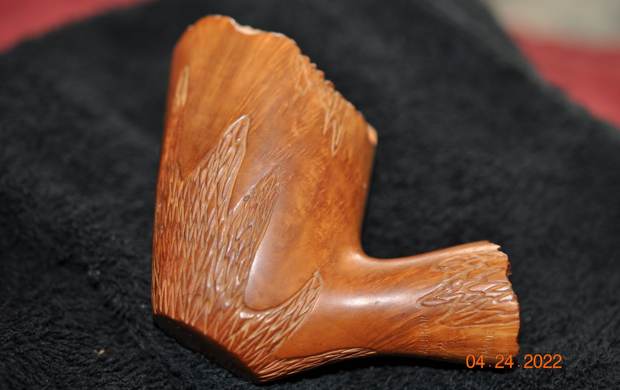
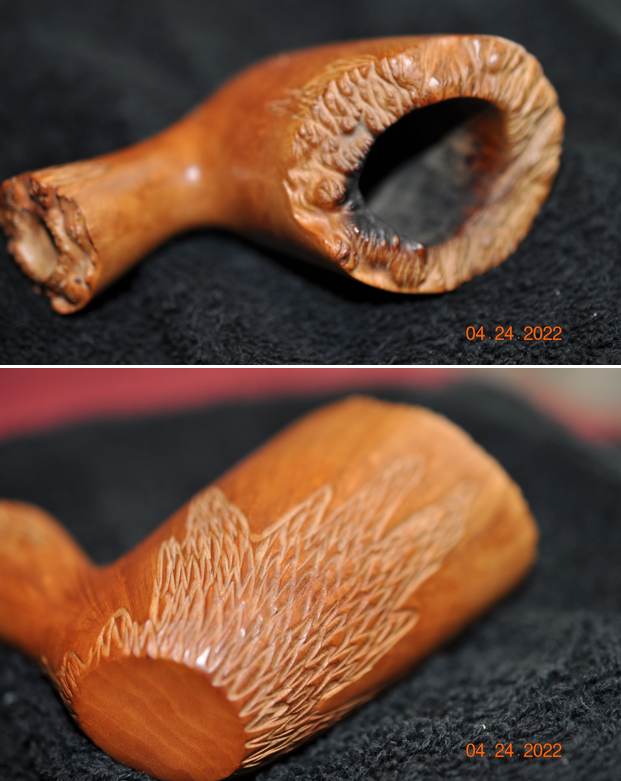 He took a close up photo of the bowl and rim top to show the condition of the plateau finish. You can see the light lava and dust in the crevices of the plateau. The bowl has a light coat of lava on the walls. The inner edge of the bowl is in excellent condition.
He took a close up photo of the bowl and rim top to show the condition of the plateau finish. You can see the light lava and dust in the crevices of the plateau. The bowl has a light coat of lava on the walls. The inner edge of the bowl is in excellent condition.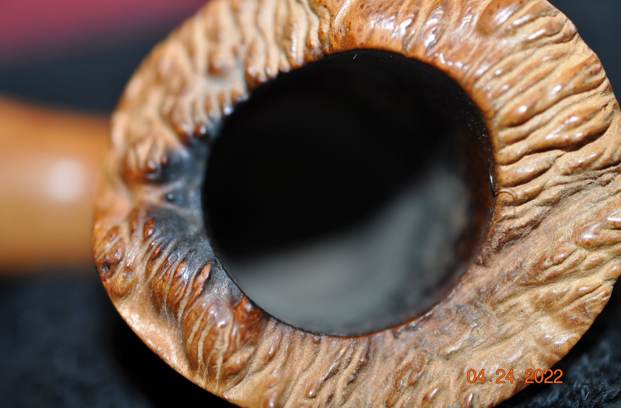 Jeff took 2 photos of the stamping on the underside of the shank to capture it. It was clear and as noted above.
Jeff took 2 photos of the stamping on the underside of the shank to capture it. It was clear and as noted above.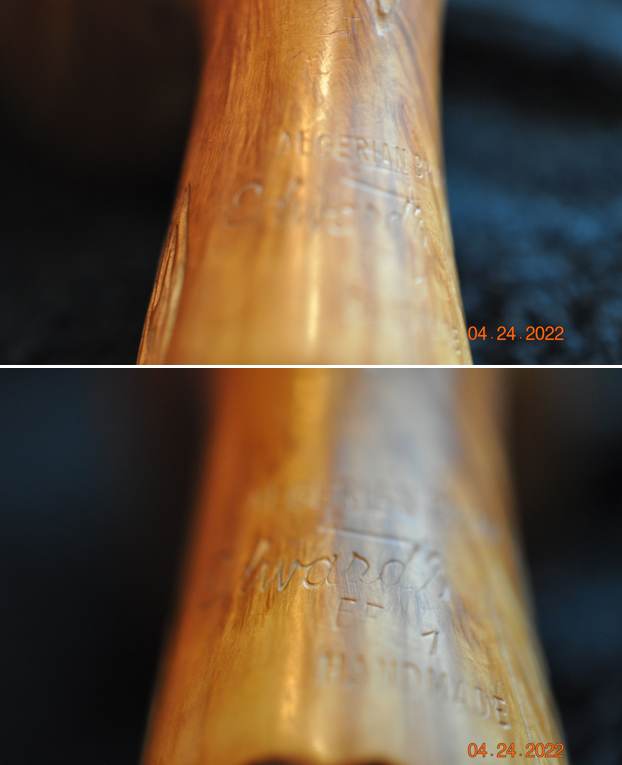 I wanted to look at who had carved the Edward’s Freehand line. I started my reading on Pipephil’s site (http://pipephil.eu/logos/en/logo-e1.html). I did a screen capture of the listing on the site and have included it below. I also included the information in the sidebar below that.
I wanted to look at who had carved the Edward’s Freehand line. I started my reading on Pipephil’s site (http://pipephil.eu/logos/en/logo-e1.html). I did a screen capture of the listing on the site and have included it below. I also included the information in the sidebar below that. Edward’s Pipes, headquartered in Tampa, FL, got its start importing pipes from France and continued to do so from 1958 to 1963 when it started producing pipes in Florida from prime Algerian Briar, a practice they continue to this day (2010). Randy Wiley, pipecarver in the USA, got his start at Edward’s.
Edward’s Pipes, headquartered in Tampa, FL, got its start importing pipes from France and continued to do so from 1958 to 1963 when it started producing pipes in Florida from prime Algerian Briar, a practice they continue to this day (2010). Randy Wiley, pipecarver in the USA, got his start at Edward’s.
I then turned to the Edwards listing on Pipedia (https://pipedia.org/wiki/Edward’s) and found the following information. I quote the information in that article below.
Edward’s pipes were originally produced in Saint-Claude, France when Francais actually was a world-class pipe maker with longstanding business & political connections to Colonial Algeria that allowed them to obtain the finest briar.
During the tumultuous 1960’s, Edward’s created a business model to offer the finest briar available in both Classic and Freehand shapes – all at a fair price. They bought the company & equipment and cornered the market on the finest, choice Algerian Briar just before the supply vanished in political turmoil of Algeria’s independence. Edward’s packed up both machinery and briar-treasure to America, safely caching the essentials to create a new pipe-making dynasty. This was a coup, for the 70’s and 80’s were grim years for pipe smokers as quality briar all but disappeared.
Edward’s Design Philosophy is hard to pin down, think of their style as the “American Charatan” with unique & clever twists all their own. Today, they fashion pipes in several locations across the USA. All of Edward’s pipes are Algerian Briar – a fact very few pipe companies can claim, and all are oil-cured utilizing natural finishes – no strange concoctions are used to interfere in your tastebud’s dance with the briar. Algerian, Calabrian, Sardinian, Corsican – take your pick, but Algerian Briar is generally considered the finest smoking briar ever used. When combined with oil-curing, Algerian takes on a magical quality that even Alfred Dunhill recognized as far back as 1918 as the choice for both his Bruyere and Shell.
The pipe that I was working came from the Edward’s workshops. From what I knew of the history of the company I think that it was American made in the 70’s after they had bought out the French company and brought the equipment and briar to the US. The Freehand shape also fits the popularity of that shape in the 70’s.
Now it was time to work on the pipe on my end. When I received it Jeff had once again done an amazing job cleaning the pipe. He reamed it with a PipNet pipe reamer and got rid of the cake. He cleaned up the reaming with a Savinelli Fitsall Pipe Knife so that we could see the walls of the bowl and assess for damage. He cleaned the internals of the shank and stem with alcohol, pipe cleaners and alcohol. He scrubbed the exterior with undiluted Murphy’s Oil Soap and a tooth brush. He rinsed the pipe under warm water. He dried it off with a cloth and then let it air dry. I took pictures of the pipe this morning to show how it looked before I started my work.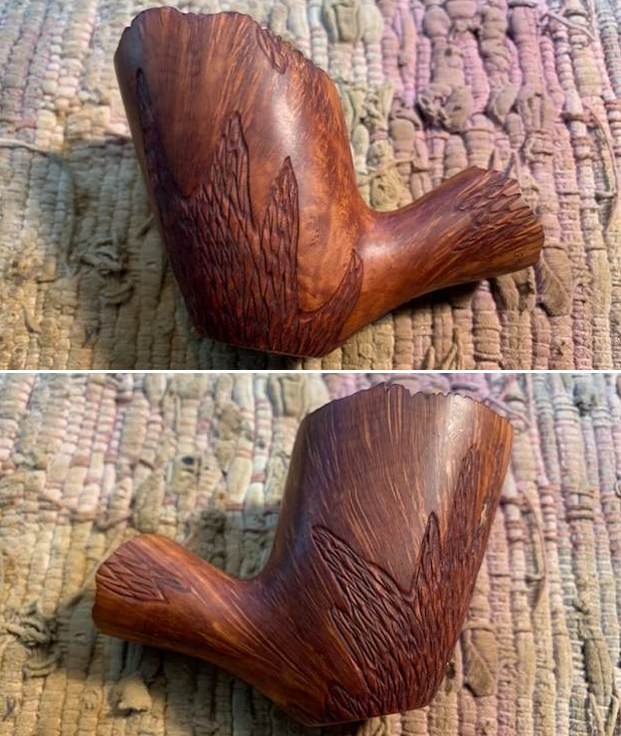
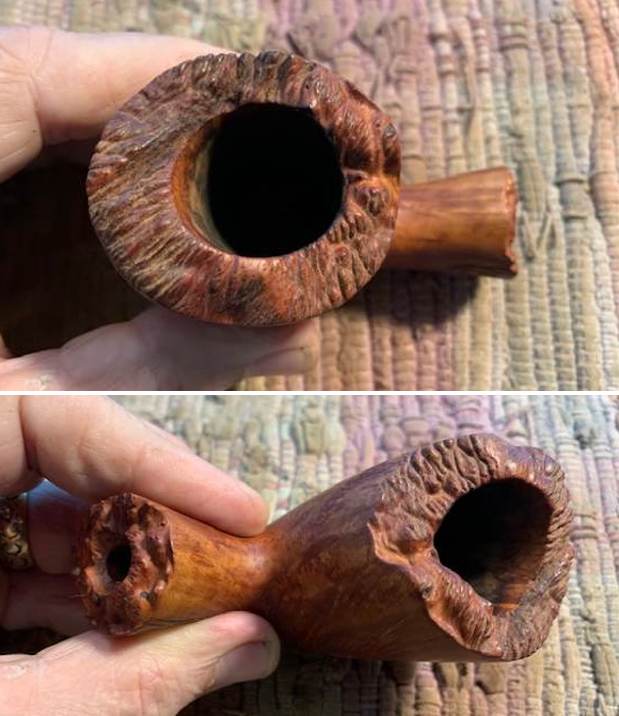
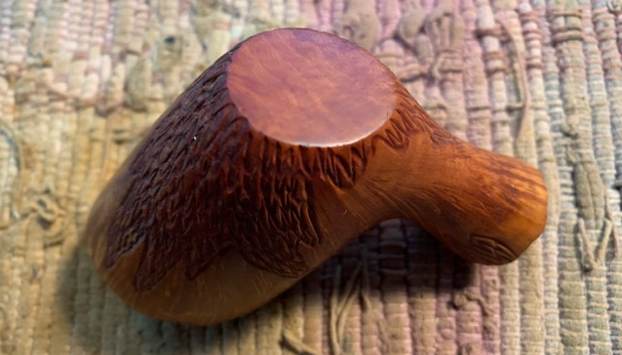 I took a photo of the plateau on the rim top to show how clean it was and to see a well executed finish on the rim top. The ravines, crevices and high points were very beautiful.
I took a photo of the plateau on the rim top to show how clean it was and to see a well executed finish on the rim top. The ravines, crevices and high points were very beautiful. 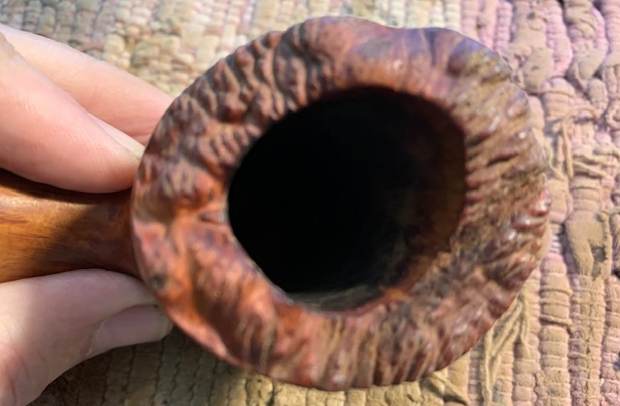 I took photos of the stamping on the underside of the shank. It had some colour in the stamp (like ones in the photos on the Pipedia site). It made the stamp very readable.
I took photos of the stamping on the underside of the shank. It had some colour in the stamp (like ones in the photos on the Pipedia site). It made the stamp very readable.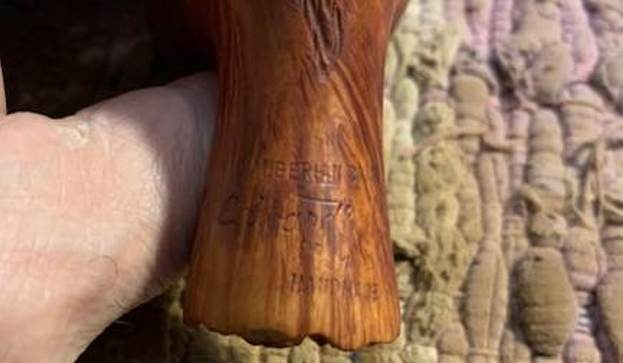 I polished the briar with micromesh sanding pads – dry sanding with 1500-12000 grit pads. I wiped the bowl down after each pad to remove any sanding debris left behind. The bowl began to shine through the process.
I polished the briar with micromesh sanding pads – dry sanding with 1500-12000 grit pads. I wiped the bowl down after each pad to remove any sanding debris left behind. The bowl began to shine through the process.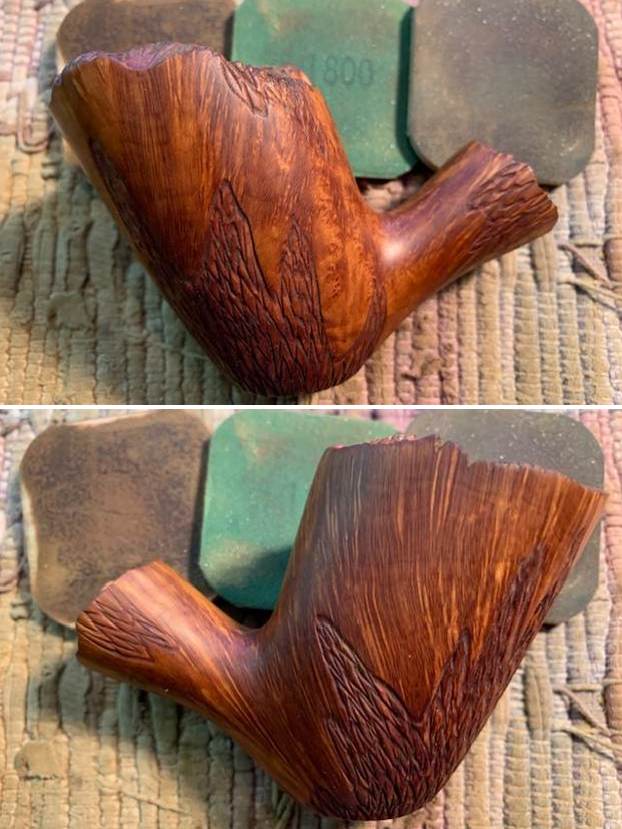
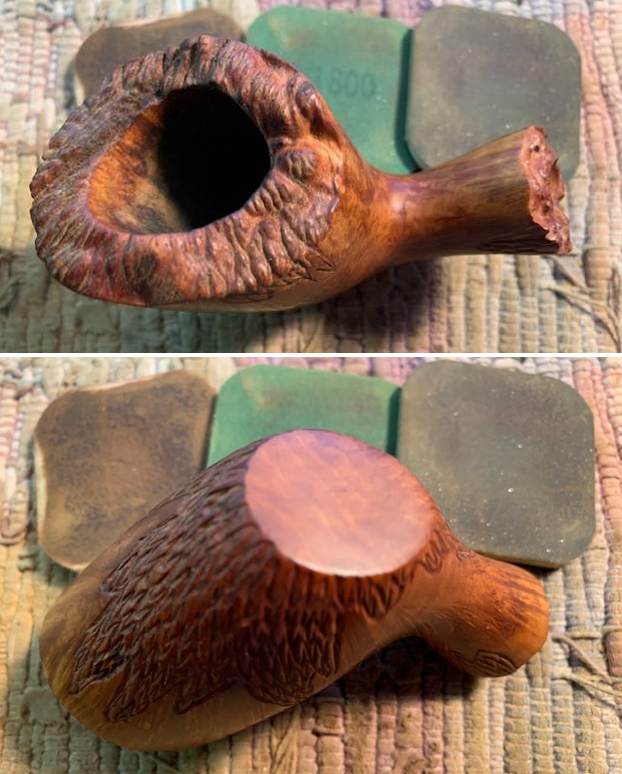
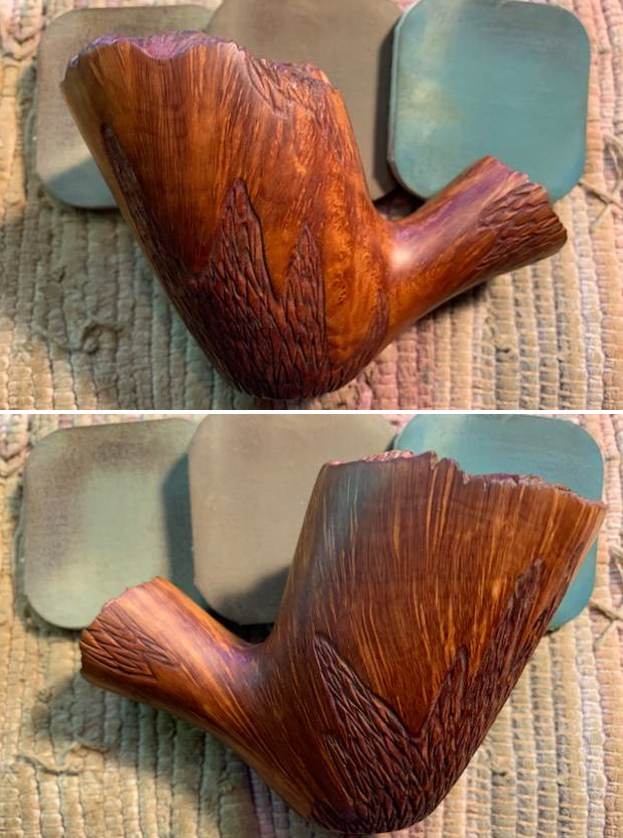
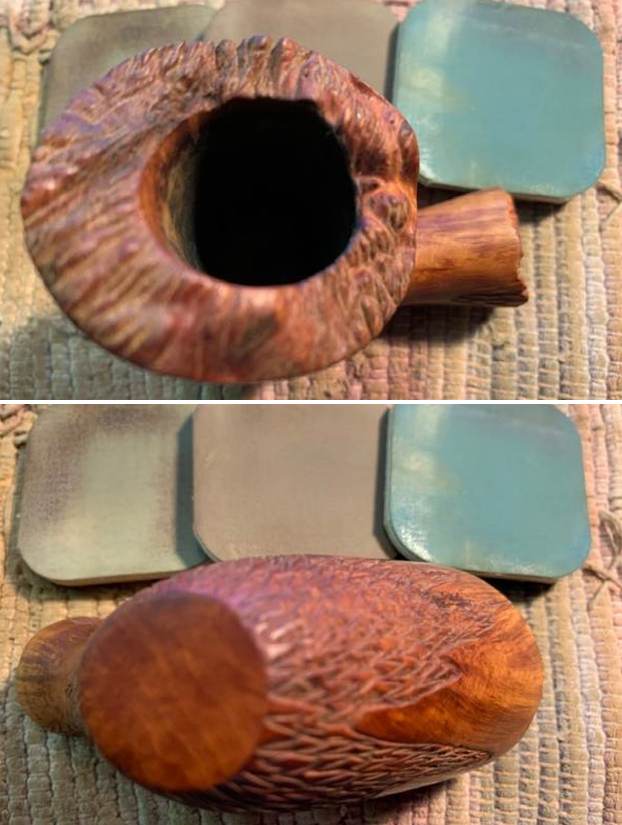
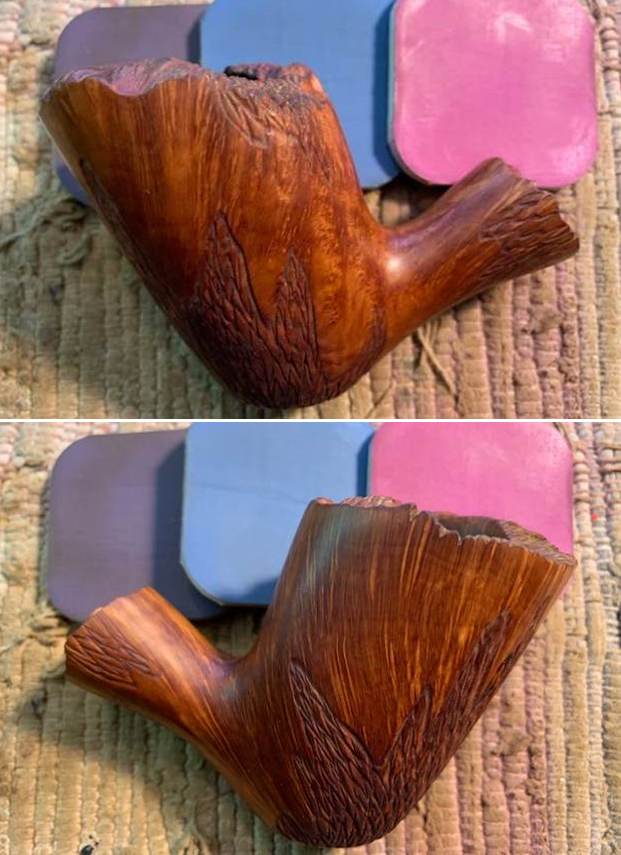
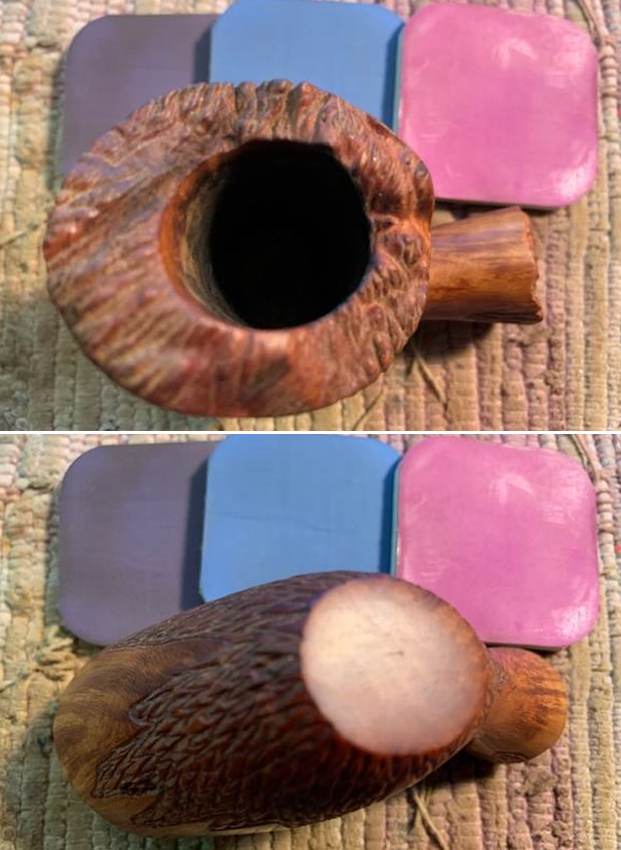 I worked some Before & After Restoration Balm into the surface of the briar with my fingertips and into the plateau rim top and shank end with a horsehair shoe brush to clean, enliven and protect it. I let the balm sit for 10 minutes and then buffed the bowl with a cotton cloth to raise the shine. The photos show the bowl at this point in the restoration process.
I worked some Before & After Restoration Balm into the surface of the briar with my fingertips and into the plateau rim top and shank end with a horsehair shoe brush to clean, enliven and protect it. I let the balm sit for 10 minutes and then buffed the bowl with a cotton cloth to raise the shine. The photos show the bowl at this point in the restoration process. 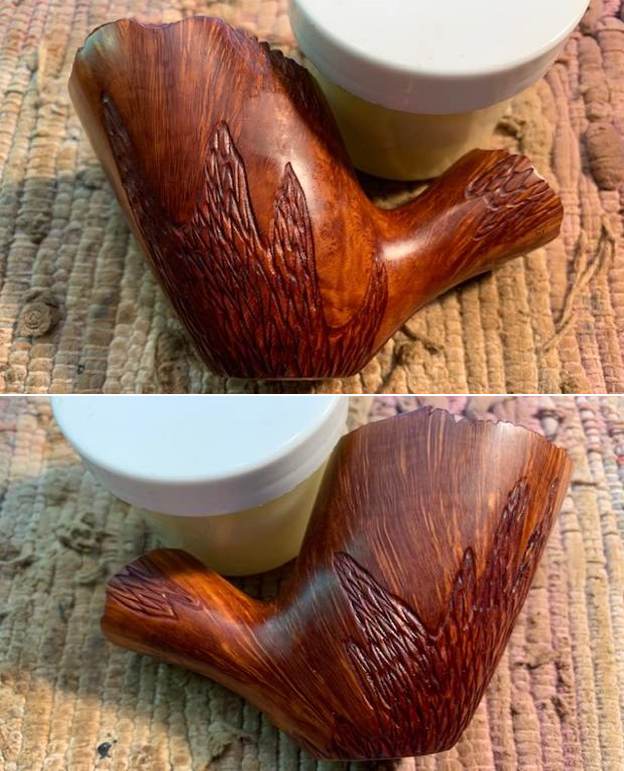
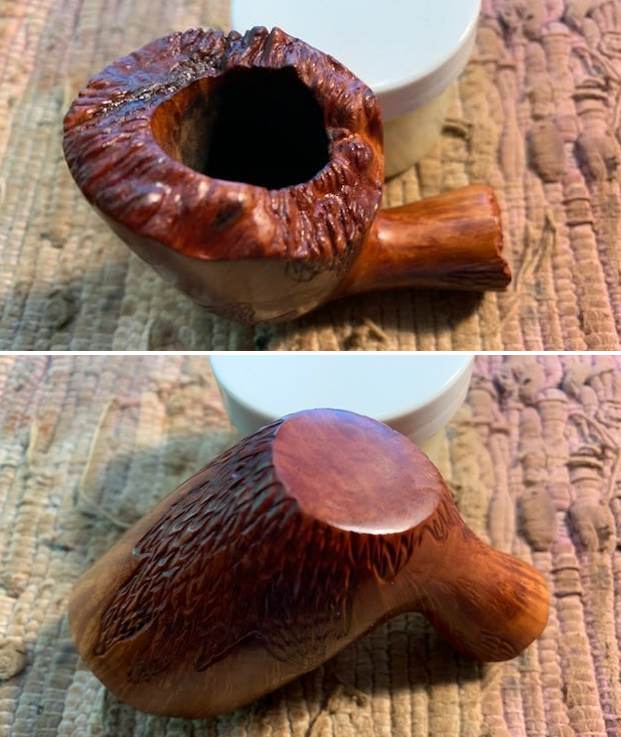
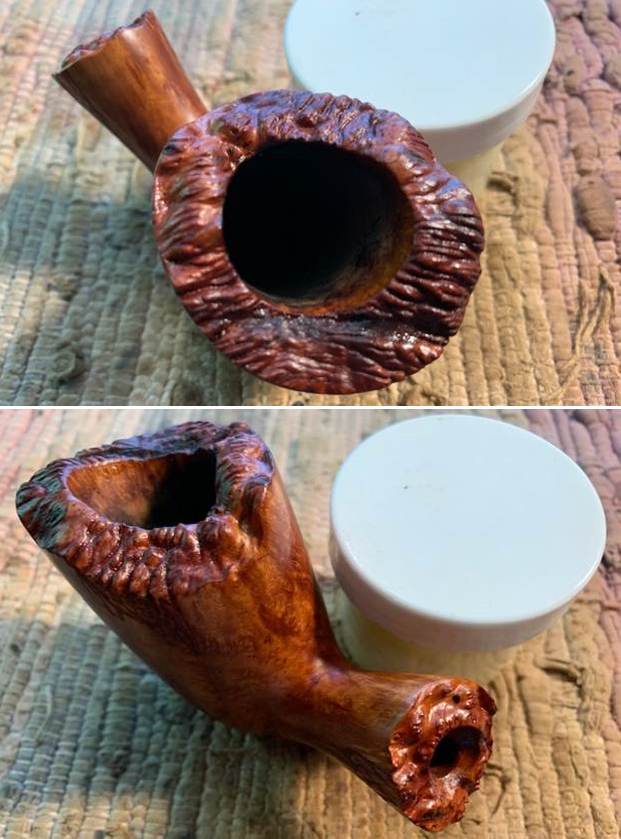 I had a nice looking fancy turned stem in my collection of stems. It will well with this pipe. I will need to polish the stem to remove the casting marks and give it a slight bend. The tenon was the right size so with some polishing it was a perfect fit.
I had a nice looking fancy turned stem in my collection of stems. It will well with this pipe. I will need to polish the stem to remove the casting marks and give it a slight bend. The tenon was the right size so with some polishing it was a perfect fit. 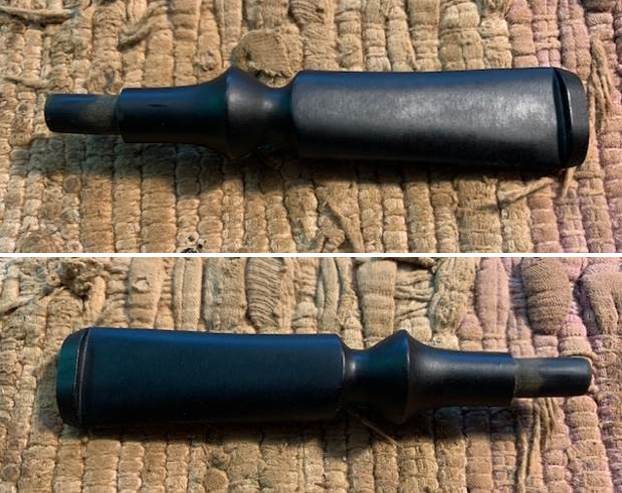 With a nostalgic flash from the past I decided to give the stem a slight bend to match the flow of the bowl using a cup of boiling water. I put enough water in a coffee cup to cover the amount of stem I wanted to soften to bend. I put it in the microwave until it was boiling then dropped the stem in the hot water. I let it sit until it was pliable and then removed it and bent it the amount I was looking for. I cooled the bent stem with running cold water and dried it off.
With a nostalgic flash from the past I decided to give the stem a slight bend to match the flow of the bowl using a cup of boiling water. I put enough water in a coffee cup to cover the amount of stem I wanted to soften to bend. I put it in the microwave until it was boiling then dropped the stem in the hot water. I let it sit until it was pliable and then removed it and bent it the amount I was looking for. I cooled the bent stem with running cold water and dried it off.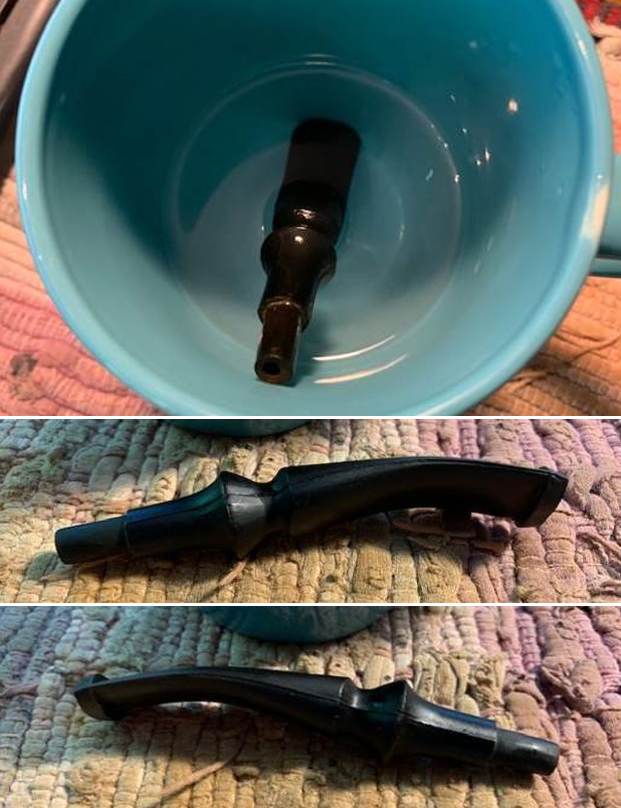 I sanded out the tooth chatter and light marks ahead of the button on both sides with 220 grit sandpaper and also smooth out the casting marks on the sides. I started polishing the stem with 400 grit wet dry sandpaper to smooth out the sanding marks left behind by the 220 grit paper.
I sanded out the tooth chatter and light marks ahead of the button on both sides with 220 grit sandpaper and also smooth out the casting marks on the sides. I started polishing the stem with 400 grit wet dry sandpaper to smooth out the sanding marks left behind by the 220 grit paper. 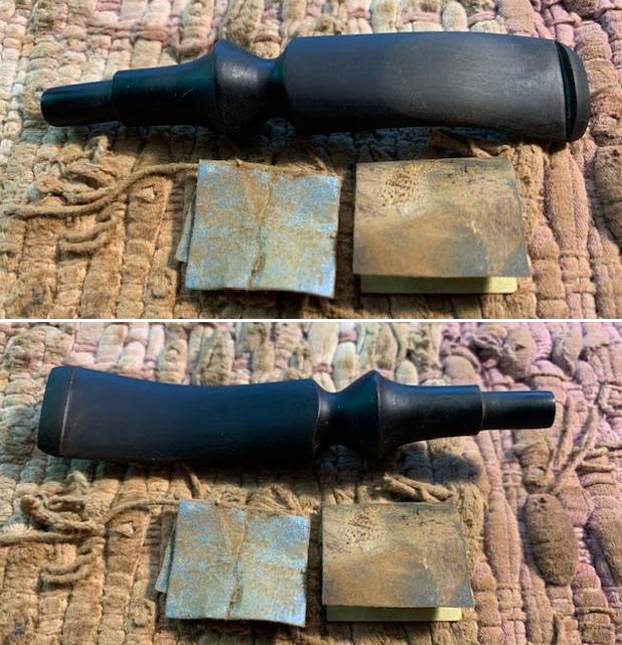 I polished the stem with micromesh sanding pads – wet sanding with 1500-12000 grit sanding pads. I wiped it down after each sanding pad with some Obsidian Oil. I finished polishing it with Before & After Pipe Stem Polish – both Fine and Extra Fine and buffed it off with a cotton cloth.
I polished the stem with micromesh sanding pads – wet sanding with 1500-12000 grit sanding pads. I wiped it down after each sanding pad with some Obsidian Oil. I finished polishing it with Before & After Pipe Stem Polish – both Fine and Extra Fine and buffed it off with a cotton cloth.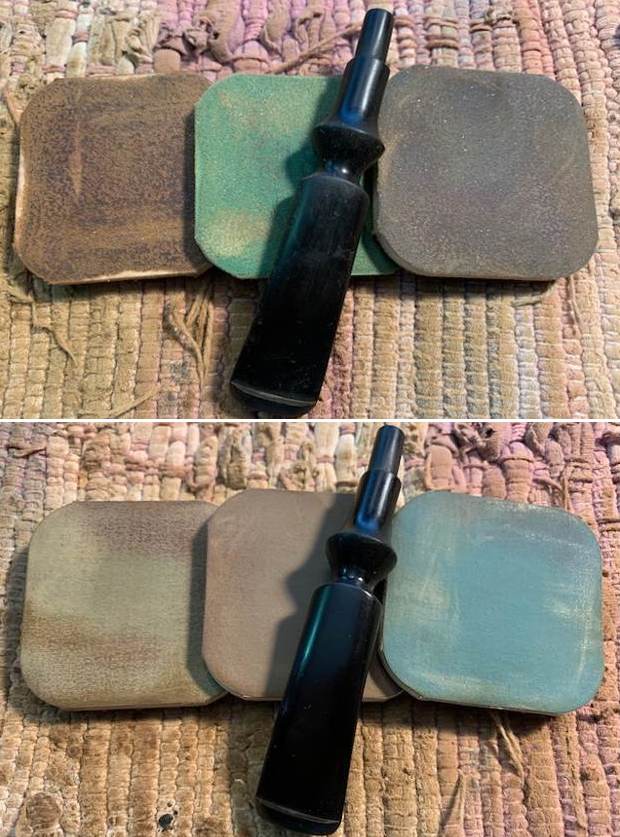
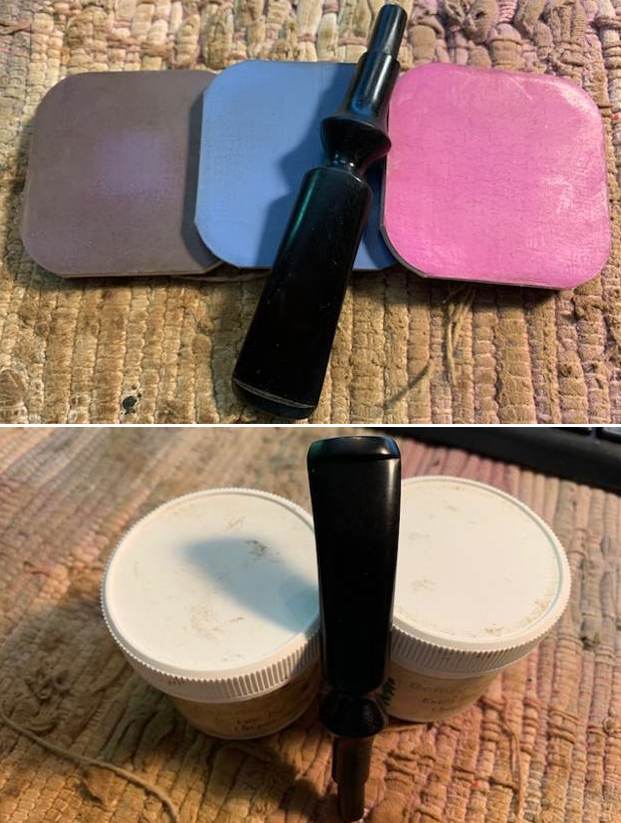 This is a beautiful Algerian Briar Edwards 8F 1 Handmade Freehand with a fancy, turned, black vulcanite stem. It has a great look and feel. The shape fits well in the hand with the curve of the bowl and shank junction a perfect fit for the thumb around the bowl when held. I polished stem and the bowl with Blue Diamond polish on the buffing wheel. I gave the plateau on the rim top and shank end multiple coats of Conservator’s Wax. I gave the bowl and the stem multiple coats of carnauba wax. I buffed the pipe with a clean buffing pad to raise the shine. I hand buffed it with a microfiber cloth to deepen the shine. The pipe polished up pretty nicely. The rich combination of browns and black in the smooth finishes and the plateau areas took on life with the buffing. The rich colour of the briar works well with the polished vulcanite stem. I like the grain and finished look of this Edwards Handmade 8F 1 Freehand pipe. Have a look at it with the photos below. The shape, finish and flow of the pipe and stem are very well done. The dimensions are Length: 6 ½ inches, Height: 3 inches, Outside diameter of the bowl: 1 ¾ wide, Chamber diameter: 1 inch. The weight of the pipe is 2.82 ounces/80 grams. This Freehand is a real beauty. Thanks for walking through the restoration with me as I worked over another beautiful pipe. This one will be going on the rebornpipes store in the American Pipe Making Section shortly if you would like to add it to your collection. Thanks for your time.
This is a beautiful Algerian Briar Edwards 8F 1 Handmade Freehand with a fancy, turned, black vulcanite stem. It has a great look and feel. The shape fits well in the hand with the curve of the bowl and shank junction a perfect fit for the thumb around the bowl when held. I polished stem and the bowl with Blue Diamond polish on the buffing wheel. I gave the plateau on the rim top and shank end multiple coats of Conservator’s Wax. I gave the bowl and the stem multiple coats of carnauba wax. I buffed the pipe with a clean buffing pad to raise the shine. I hand buffed it with a microfiber cloth to deepen the shine. The pipe polished up pretty nicely. The rich combination of browns and black in the smooth finishes and the plateau areas took on life with the buffing. The rich colour of the briar works well with the polished vulcanite stem. I like the grain and finished look of this Edwards Handmade 8F 1 Freehand pipe. Have a look at it with the photos below. The shape, finish and flow of the pipe and stem are very well done. The dimensions are Length: 6 ½ inches, Height: 3 inches, Outside diameter of the bowl: 1 ¾ wide, Chamber diameter: 1 inch. The weight of the pipe is 2.82 ounces/80 grams. This Freehand is a real beauty. Thanks for walking through the restoration with me as I worked over another beautiful pipe. This one will be going on the rebornpipes store in the American Pipe Making Section shortly if you would like to add it to your collection. Thanks for your time.